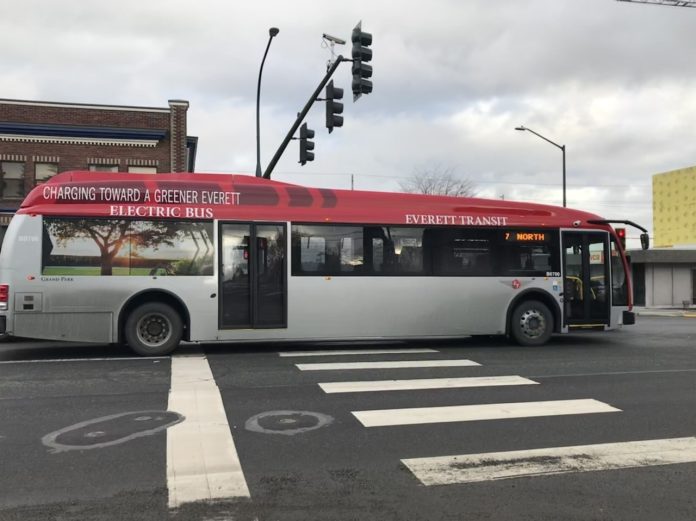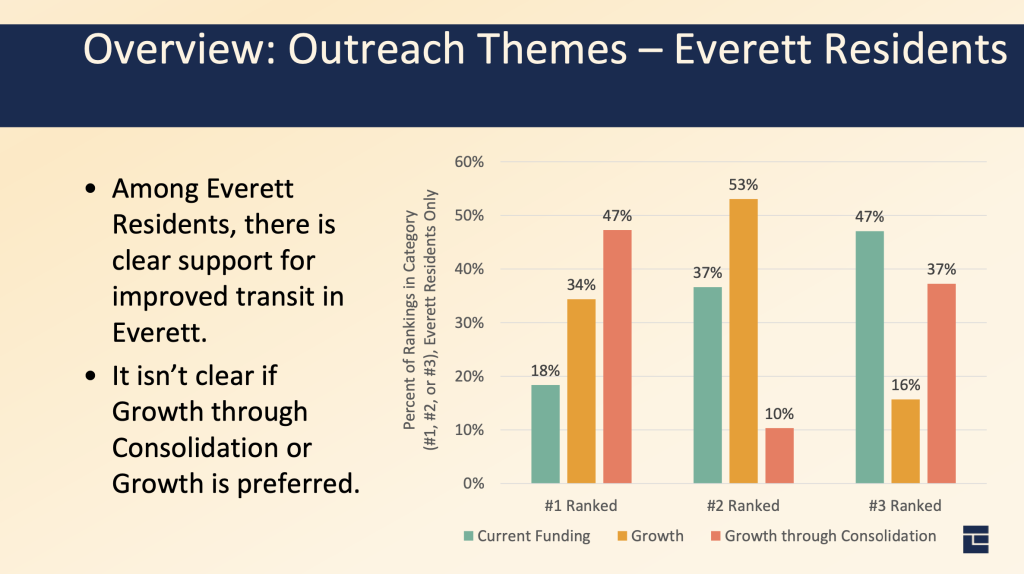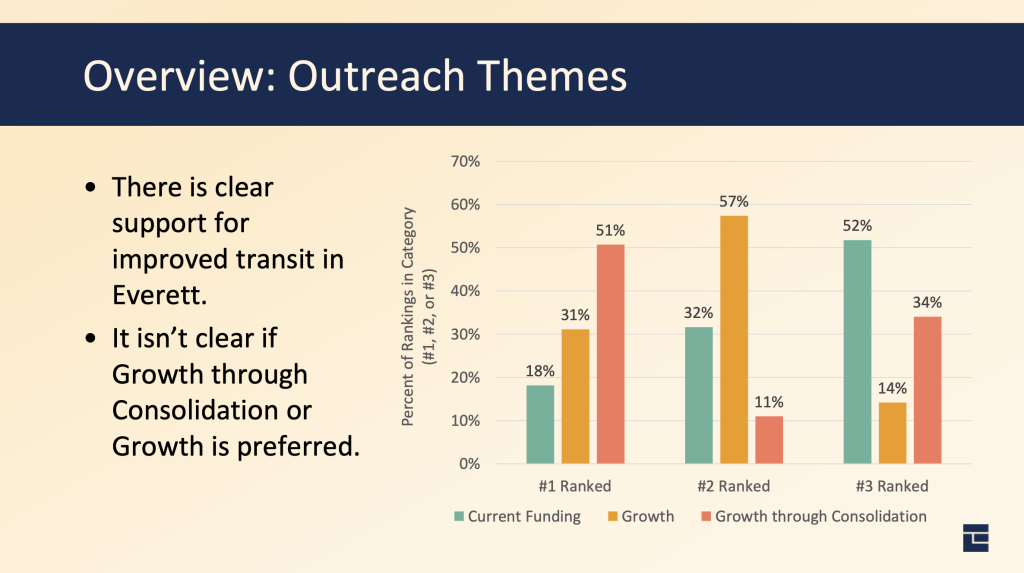A merger of Everett Transit with Community Transit that would significantly increase transit service in the region may still have legs. Everett policymakers have decided that a coordinated effort between the two transit agencies, which would need to be approved by Everett voters, should move ahead. Next steps include determining how a merger could proceed and developing scenarios for local transit service. Two fallback options remain if a merger between the two transit agencies fails to garner enough support, but results from a public survey indicate Everett residents are supportive of transit expansion.
The decision to move forward with the merger was informed by a presentation to the Everett City Council this past June in which transit agency management shared public outreach findings on the potential merger and two alternative scenarios. City councilmembers also received additional context on where Everett Transit stands in the interim given current funding and what service improvements the agency could achieve with additional financial resources and a merger.
The three options
Looking at its transit future, Everett has three general options to choose from:
- Current Funding – This is the do nothing alternative, which relies on continuation of a 0.6% sales tax to fund transit operations and capital investments. It provides little in the way of making measurable improvements to the system.
- Sustainable Growth – This is an alternative where Everett Transit continues to be the system operator but is able to grow. It relies upon Everett voters approving a measure to increase the sales tax to 0.9%. In the course of ten years, annual bus service hours could reach 140,000 in the city.
- Growth through Consolidation – This is an alternative where Everrett Transit merges with Community Transit. It relies on Everett voters approving a measure to annex into Community Transit’s taxing district and authorizing an increase in the sales tax to 1.2% (this is Community Transit’s current rate). In the course of two years, annual bus service hours could reach 140,000 in the city — and likely go much higher in the following years.
The survey results
Everett ran a survey on the different options. There was a strong consensus that the status quo Current Funding approach is not desirable. Instead, people were generally supportive of Growth through Consolidation as a first choice, though many Everett residents also supported the Sustainable Growth option.
Surveyed people who chose the different options tended to reflect certain types of views. People who highly ranked the Current Funding approach tended to reflect anti-tax opinions and suggested fare increases whereas people who strongly supported Sustainable Growth expressed unfounded fears, such as loss of local control, local transit, and paratransit. Conversely, people who supported Growth though Consolidation indicated that it would improve regional connections, create a more efficient network, increase frequencies, and encourage more people to ride transit who don’t already.
The interim for Everett Transit
The outlook for Everett Transit is not very ambitious given that the agency is poorly funded. However, pandemic relief funding from the federal government has come through in three rounds so far, the latest being the American Rescue Plan of 2021. That’s provided another $12 million to the agency. The agency had already received funding $14 million from the other two Congressional emergency appropriations made last year.
The spate of federal pandemic relief funding will allow Everett Transit to increase some service levels this weekend. That could be followed by another small increase in March, but the agency has warned that it won’t add service that cannot be sustained. Service increases will primarily be focused on weekends, evenings, and other off-peak periods where existing bus fleet levels can support growth.
The future of transit in Everett
During the June meeting, Everett Transit Director Tom Hingson posed a big question for city councilmembers to center their thinking around. “What is the best decision for Everett as it becomes a light rail community?”
Hingson said that the Sustainable Growth alternative is not a sufficient permanent solution. Instead, it would only be useful as a stopgap measure if it’s acted upon by 2026 to partially meet intermediate needs. “The best long-term option appears to be consolidation,” he said. “[It] leverages a larger entity with a historically stronger rate of sales tax growth to serve the transportation needs of the county’s largest city and eventual northern terminus of Link light rail.”
Some specifics that Hingson offered in relation to the Sustainable Growth option were related to sustainable service hours and service levels. He said that it could eventually fund up to 140,000 annual service hours, nearly double existing service, but noted that would still fall short of the 200,000 annual service hours needed to support a light rail community. In terms of service levels, Hingson illustrated how low they are today with only one route running at 15-minute frequencies — which in a city is still barely making it — while most routes run less frequently than every 30 minutes and some only hourly. Doubling that at best is still substandard and isn’t the kind of service model likely to get people to walk from their front door to transit unless they have no other option.
Hingson did concede, however, that a decision on a consolidated merger could be delayed until 2036 if a stopgap funding measure were approved by voters or the city were successful in obtaining state legislative approval for more revenue options, such as increasing the city sales tax rate for transit to 1.2%. (In reality, the city already has a multitude of local taxing options for transit, but there’s never been any creative thinking around this, such as new impact fees, car tab fees, parking fees and taxes, and property tax levies.)
After Hingson’s presentation, city councilmembers followed up with discussion. Perhaps the most labored portion of this came from Councilmember Jeff Moore who deeply misunderstood the information presented about a merger and seemed unwilling to listen to staff — going as far to admit that fact. Nevertheless, Hingson clarified that a key process before making a decision to move forward with a merger would be developing a conceptual route network and possible service levels. Models used just for the initial stage of the alternatives process have shown a “much more robust network under the merged system than Everett Transit would be able to provide at nine-tenths [of a percent tax],” Hingson said. He further dispelled the idea that Everett would be getting less of a bus network for the value put into it.
Councilmember Liz Vogeli said she was supportive of commissioning an interagency workgroup to study and evaluate a merger scenario with Community Transit. She felt that this would help the city council could better understand whether or not it would be worth pursuing as an option with the public.
Council President Brenda Stonecipher essentially concurred and said that latest report wasn’t terribly illuminating. Much of the feedback was similar to what they’ve heard over the past few years, she said, which is that “the status quo is not acceptable.” With booming growth and an additional 60,000 residents projected to be headed for Everett in the years ahead, Stonecipher said, “I don’t think we can grow in a way to maintain our quality of life if we don’t have a well functioning transit system.” she said.
Ultimately, Stonecipher argued that the city council shouldn’t wait to act on moving an interagency workgroup forward and was able to bring most of the city council — Moore being the exception — onboard with the idea to form such a group to explore integration and service options. A steering committee will be composed of elected officials and community leaders to guide the interagency work. In conjunction, Everett Transit and Community Transit staff will develop a plan that could lead to a merger ballot measure.
However, a ballot measure to merge or even just increase the sales by three-tenths of cent may be a few years away yet. Hingson said that a measure would ideally go before voters by 2024 — a presidential election year and the year that Link reaches Snohomish County via Lynnwood — and be fully implemented by 2026. So the process could still unfold over the next year three years.
Stephen is a professional urban planner in Puget Sound with a passion for sustainable, livable, and diverse cities. He is especially interested in how policies, regulations, and programs can promote positive outcomes for communities. With stints in great cities like Bellingham and Cork, Stephen currently lives in Seattle. He primarily covers land use and transportation issues and has been with The Urbanist since 2014.





